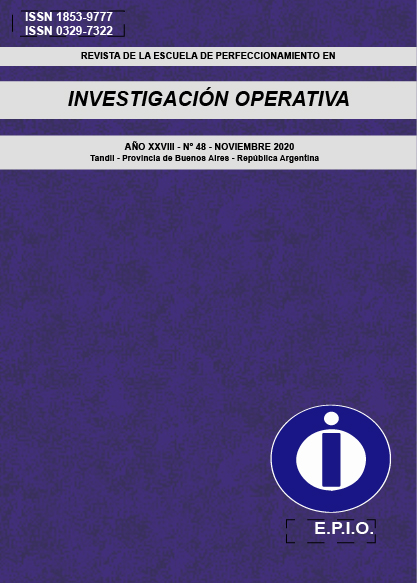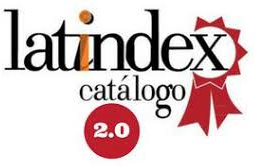Evaluación de una plataforma de carpooling mediante experimentos de selección
Palabras clave:
carpooling, experimento de selección, modelo de selección discreta, transporte urbanoResumen
La ciudad de Buenos Aires sufre un incesante aumento de la congestión de sus principales vías de acceso, con el consecuente deterioro ambiental. El carpooling constituye una posible solución, complementaria al transporte público, con la flexibilidad y el confort del vehículo particular.
En el presente estudio se investiga el interés de los habitantes de la ciudad de Buenos Aires por un potencial sistema de carpooling basado en una red social, materializada mediante una plataforma online que permite a oferentes y demandantes de un viaje encontrarse y acordar las condiciones. El sistema no supone la existencia de un organizador con fines de lucro ni de conductores profesionales. Como incentivo se plantea la implementación de un carril preferencial exclusivo para vehículos adheridos al sistema de carpooling en las principales vías de acceso a la ciudad. La validación empírica se realiza mediante un experimento de selección, que añade el carpooling a las alternativas de transporte existentes. Se proponen diferentes escenarios variando el tiempo de viaje y el costo para cada medio y se lo distribuye a través de un instrumento online a una muestra representativa. Los resultados del experimento se analizan mediante modelos de selección discreta, para determinar las curvas de oferta y demanda del sistema, para evaluar la viabilidad del sistema.
Descargas
Referencias
Abrahamse W., Keall M. (2012). Effectiveness of a web-based intervention to encourage carpooling to work: a case study of wellington, New Zealand. Transport Policy, 21, 45-51.
Asociación de Fábricas Argentina de Componentes. http://www.afac.org.ar/
Almeida Correia G., Abreu E Silva J., Viegas J.M. (2013): Using latent attitudinal variables estimated through a structural equations model for understanding carpooling propensity. Transportation Planning and Technology 36 (6).
Baldassare M., Ryan S., Katz C. (1998). Suburban attitudes toward policies aimed at reducing solo driving. Transportation, 25, 99-117.
Ben-Akiva M., Lerman S. (1985). Discrete choice analysis: theory and application to travel demand. MIT Press.
Borriello A., Scagnolari S., Maggi R. (2015). Are commuters in Lugano ready to leave the car? evaluating conventional and innovative solutions to facilitate the switch. Conference Paper STRC 2015 (Swiss Transport Research Conference).
Chan N.D., Shaheen A.S. (2012). Ridesharing in North America: past, present, and future. Transport Reviews,32 (1), 93-112.
Correia G., Viegas J.M. (2011). Carpooling and carpool clubs: clarifying concepts and assessing value enhancement possibilities through a stated preference web survey in Lisbon, Portugal. Transportation Research Part A, 45, 81-90.
Delhomme P., Gheorghiu A. (2016). Comparing French carpoolers and non-carpoolers: whoch factors contribute the most to carpooling? Transportation Research Part D, 42, 1-15.
Dorinson D., Gay D., Minett P., Shaheen S. (2009). Flexible carpooling: exploratory study. University of California Davis.
Dunlap R. E., Van Liere K. D., Mertig A. G., Jones R. E. (2000). New trends in measuring environmental attitudes: measuring endorsement of the new ecological paradigm: a revised nep scale. Journal of Social Issues, 56 (3), 425-442.
Flannelly K.J., Mc Leod M.S. (1989). A multivariate analysis of socioeconomic and attitudinal factors predicting commuters’ mode of travel. Bulletin of the Psychonomic Society, 27(1), 64-66.
Gärling T., Schuitema G. (2007). Travel demand management targeting reduced private car use: effectiveness, public acceptability, and political feasibility. Journal of Social Issues, 63(1), 139-153.
Gobierno de la Ciudad de Buenos Aires. Plan de mobilidad sustentable. https://fr.slideshare.net/dianamondino/transporte-buenos-aires-2020-plan-de-movilidad-20-g-krantzer.
Gheorghiu A., Delhomme P. (2018). For which types of trips do French drivers carpool? motivations underlying carpooling for different types of trips. Transportation Research Part A,113, 460-475.
Giuliano G., Levine D.W., Teal R.F. (1990). Impact of high occupancy vehicle lanes on carpooling behavior. Transportation 17(2), 159-177.
Instituto Nacional de Estadística y Censos: Censo 2010: https://www.indec.gob.ar/indec/web/Nivel4-Tema-2-41-135.
Koppelman F.S., Bhat C.R., Schofer J.L. (1993). Market research evaluation of actions to reduce suburban traffic congestion: commuter travel behavior and response to demand reduction actions. Transportation Research Part A, 27(5), 383-393.
Levofsky A., Greenberg A. (2001). Organized dynamic ride sharing: the potential environmental benefits and the opportunity for advancing the concept”. Transportation Research Board Annual Meeting 2001.
Margolin J.B., Lisch M.R., Stahr M. (1978). Incentives and disincentives of ride sharing. Program of Policy Studies in Science and Technology, George Washington University.
Massaro D.W., Chaney B., Bigler S., Lancaster J., Iver S., Gawade M., Eccleston M., Gurrola E., Lopez A. (2014). Carpool now: just in time carpooling without elaborate preplanning. Procedia Computer Science, 37, 396-403.
Mc Fadden D. (1997). Measuring willingness-to-pay for transportation improvements. University of California.
Mc Fadden D., Train K.E. (2000). Mixed MNL models for discrete response”. Journal of Applied Econometrics, 81, 447-770.
Meyer E. (2014). The culture map: breaking through the invisible boundaries of global business. Public Affairs.
Minett P., Pearce J. (2011). Estimating the energy consumption impact of casual carpooling. Energies 4 (1), 126-139.
Morrales Sarriera J., Escovar G., Blynn K., Alesburry A., Scully T., Zhao J. (2017). To share or not to share. investigating the social aspects of dynamic ridesharing. Transportation Research Record, 109-117.
Neoh J.G., Chipulu M., Marshall A. (2015). What encourages people to carpool? an evaluation of factors with meta-analysis. Transportation 44 (2), 423-447.
Otero I., Nieuwenhuijsen M.J., Rojas-Rueda D. (2018). Health impacts of bike sharing systems in Europe”. Environment international, 115, 387-394.
SAIMO (2015): El nivel socioeconómico en ARGENTINA. Sociedad Argentina de Investigadores de Mercado y Opinion. http://www.saimo.org.ar/observatorios/observatorio-social.
Shaheen S.A., Chan N.D., Gaynor T. (2016). Casual carpooling in the San Francisco bay area: understanding user characteristics, behaviors, and motivations. Transport Policy, 51, 165-173.
Steg L., Vlek C., Slotegraaf G. (2001). Instrumental-reasoned and symbolic-affective motives for using a motor car. Transportation Research Part F, 4 (3),151-169.
Teal R.F. (1987). Carpooling: who, how and why. Transportation Research Part A, 3, 203-214.
Thurstone L. L. (1927). A law of comparative judgement. Psychological Review, 34, 273-286.
Train K. (2009). Discrete choice methods with simulation. Cambridge University Press.
Triandis H. C., Gelfand M. J. (1998). Converging measurement of horizontal and vertical individualism and collectivism. Journal of personality and social psychology,74,1-118.
Wachs, M. (1990). Transportation demand management: policy implications of recent behavioral research. Journal of Planning Literature.
Wang R. (2011): Shaping carpool policies under rapid motorization: the case of Chinese cities. Transport Policy, 18, 631-635.
Zhang D., Li Y., Zhang F., Lu M., Liu Y., He T. (2013). Coride carpool service with awin-win fare model for large-scale taxicab networks. SenSys '13 Proceedings of the 11th ACM Conference on Embedded Networked Sensor Systems N° 9.
Descargas
Publicado
Número
Sección
Licencia
Derechos de autor 2020 Emilio Picasso, Mariano Bonoli Escobar, Pedro Cosatto Ammann

Esta obra está bajo una licencia internacional Creative Commons Atribución-NoComercial-CompartirIgual 4.0.
Atribución — Usted debe dar crédito de manera adecuada, brindar un enlace a la licencia, e indicar si se han realizado cambios. Puede hacerlo en cualquier forma razonable, pero no de forma tal que sugiera que usted o su uso tienen el apoyo de la licenciante.
NoComercial — Usted no puede hacer uso del material con propósitos comerciales.
CompartirIgual — Si remezcla, transforma o crea a partir del material, debe distribuir su contribución bajo la misma licencia del original.







